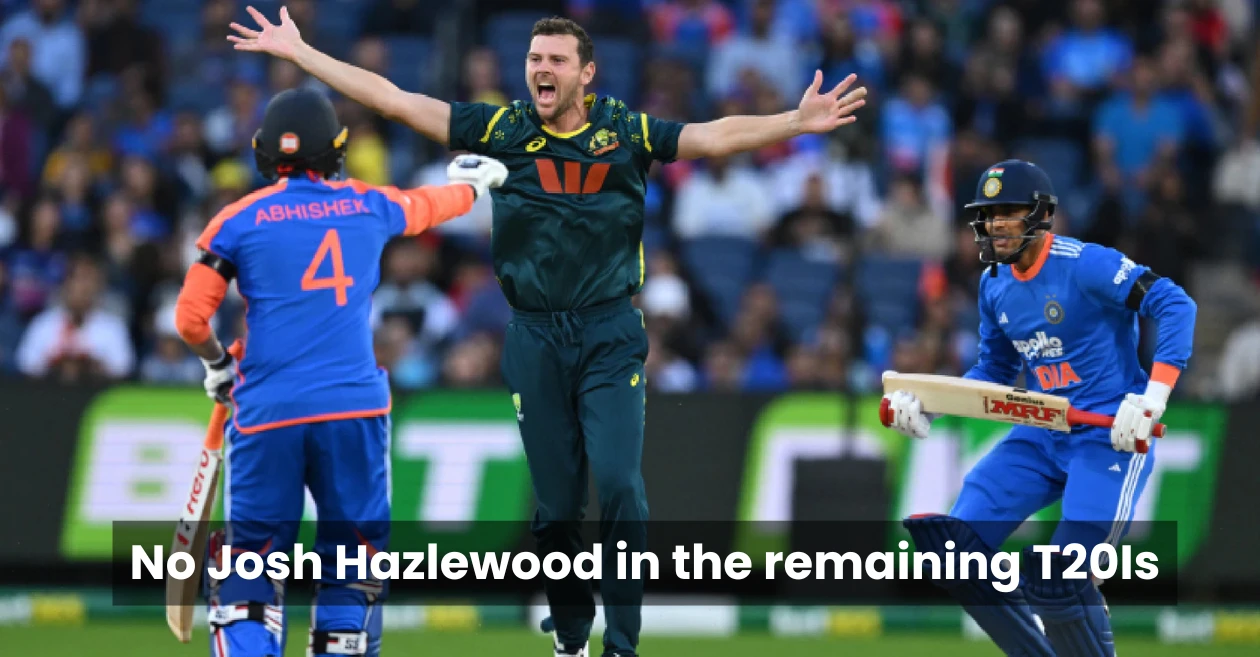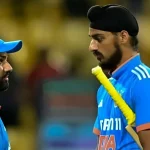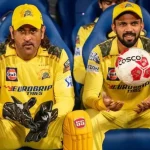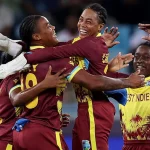Australia’s preparation for the much-anticipated Ashes 2025 has already begun, and one of its key architects, Josh Hazlewood, has made a decisive move in that direction. The veteran pacer will miss the remainder of the T20I series against India to focus on red-ball preparations ahead of the high-voltage Ashes opener, which kicks off on November 21 in Perth.
The announcement came just a day after Hazlewood delivered a match-winning performance in the second T20I at the Melbourne Cricket Ground (MCG) — a spell that earned him the Player of the Match award for his incredible figures of 3 for 13, dismantling India’s top order with surgical precision.
However, his sudden withdrawal from the remainder of the series has sparked a mix of admiration and concern — admiration for his professionalism and long-term vision, and concern for Australia’s short-term bowling firepower.
A Calculated Decision: Hazlewood Prioritizes the Ashes over T20I Glory
For Hazlewood, the timing of the decision was not incidental but intentional. With the Ashes just a few weeks away, the 34-year-old has chosen to step back from the high-intensity white-ball circuit to recalibrate his bowling for the red-ball challenge.
“The rhythm between T20s and Test cricket is completely different,” Hazlewood was quoted as saying to a local outlet before the series. “Switching from four-over spells to long bowling workloads takes time. I want to make sure I’m peaking at the right moment when the Ashes begins.”
The move underscores Hazlewood’s old-school mentality — one that values Test cricket as the ultimate format. It’s also a testament to his maturity and understanding of his body, given his recent injury-prone years. By playing a Sheffield Shield match for New South Wales against Victoria before rejoining the Test squad in Perth, Hazlewood is ensuring that his bowling rhythm is fully adapted to the rigors of long spells and sustained pressure.
Hazlewood’s Heroics at the MCG: A Masterclass in Controlled Aggression
Before exiting the T20I series, Hazlewood left his mark in style. His spell in the second T20I was a clinic in accuracy, discipline, and tactical brilliance, the kind of bowling that reminds fans why he remains one of the most dependable pacers in modern cricket.
Defending a modest total, Hazlewood removed Shubman Gill with a perfect outswinger early in the innings, followed by the crucial scalps of Suryakumar Yadav and Tilak Varma, who were looking to rebuild India’s chase. His spell of 3/13 in four overs suffocated India’s momentum and laid the foundation for Australia’s four-wicket victory, giving them a 1-0 series lead.
Commentators praised Hazlewood’s ability to extract bounce and seam movement even on a flat MCG track, a skill honed over years of experience. His knack for hitting the seam repeatedly and maintaining an economy rate below 4 in a T20 contest spoke volumes of his control and match intelligence.
A Huge Void to Fill: Hazlewood’s Absence and Its Implications
While Hazlewood’s decision makes strategic sense from a Test cricket standpoint, it leaves a significant hole in Australia’s T20 setup. His early breakthroughs have often dictated the tempo of matches, particularly during the powerplay overs, where his precision and movement make scoring difficult for even the best batters.
With Mitchell Starc rested and Pat Cummins unavailable for this series, Hazlewood’s withdrawal means that Australia’s pace department will now rely heavily on the likes of Nathan Ellis, Xavier Bartlett, and Ben Dwarshuis, along with all-rounders Marcus Stoinis and Mitchell Marsh.
For Australia, this is not just about replacing a bowler — it’s about compensating for a mindset. Hazlewood brings calm, confidence, and control; he dictates field placements and bowlers’ plans. His presence in the bowling group often uplifts younger pacers. Without him, Australia will need others to step up and lead by example.
Mitchell Marsh’s Challenge: Balancing Rotation with Results
Skipper Mitchell Marsh now faces the tricky task of managing rotation without losing momentum in the series. After the second T20I win, Marsh had praised Hazlewood’s leadership within the group, calling him “a banker with the ball, someone who makes everyone’s job easier.”
With Hazlewood gone, Marsh will turn to Nathan Ellis for consistency in the death overs and Xavier Bartlett for early swing. Ben Dwarshuis, who will feature in the 4th and 5th matches, adds variety as a left-armer, while Mahli Beardman, one of Australia’s most promising young quicks, has been included for games 3–5 — an exciting opportunity to prove himself against a powerful Indian batting lineup.
The challenge for Marsh will be ensuring that the team maintains its rhythm while giving exposure to these fresh faces ahead of next year’s T20 World Cup 2026.
Cricket Australia’s Updated Squad: Rotation and Opportunity
Following Hazlewood’s withdrawal, Cricket Australia (CA) announced a rotational squad designed to manage workloads and test depth within the ranks.
Updated Australia Squad for Remaining T20Is vs India:
Mitchell Marsh (captain), Sean Abbott (3rd game), Xavier Bartlett, Tim David, Ben Dwarshuis (4th and 5th games), Nathan Ellis, Mahli Beardman (games 3-5), Travis Head, Josh Philippe, Josh Inglis, Matthew Kuhnemann, Mitchell Owen, Matt Short, Marcus Stoinis, Adam Zampa.
The inclusion of young guns like Beardman and Bartlett highlights CA’s intent to build long-term bench strength while also preserving senior players for key assignments like the Ashes and T20 World Cup.
Why the Ashes Preparation Takes Precedence
The Ashes 2025 — scheduled to begin on November 21 at the Optus Stadium, Perth — is not just another Test series. It is the holy grail of Australian cricket, a contest steeped in legacy, pride, and national identity.
For Hazlewood, the stakes are immense. The last Ashes series in England saw him rotate with Cummins, Starc, and Scott Boland due to injury management. With the series now at home, the expectation is for the veteran trio to lead a full-strength pace attack on fast, bouncy wickets tailor-made for their skill sets.
By opting out of the T20Is, Hazlewood is taking no chances. His preparation with the red ball will focus on building stamina, consistency, and seam movement — all vital for bowling long spells under the Perth sun.
Moreover, with the Ashes marking the beginning of Australia’s new World Test Championship (WTC) cycle, the series carries extra weight in terms of points and pride. Hazlewood’s disciplined approach underlines the team’s seriousness about reclaiming dominance in Test cricket.
Analysts React: “Hazlewood’s Move Reflects Professionalism”
Cricket pundits and former players have largely supported Hazlewood’s decision, viewing it as a model example of workload management.
Former Australian captain Michael Clarke praised the timing, saying, “It’s smart. Josh knows what his body needs. You can’t be playing back-to-back T20s and expect to be at your best in a five-Test Ashes series. This shows he’s thinking long-term.”
Former fast bowler Brett Lee added, “I love that he’s putting red-ball cricket first. It’s what defines the greats. And Josh has that old-school mindset — focus, fitness, and preparation.”
Meanwhile, Indian commentator Harsha Bhogle noted the professionalism of the move from a different perspective: “It’s a big loss for the ongoing T20I series, but a huge gain for cricket lovers who want to see Hazlewood in top form at the Ashes. It’s about balance, and he’s chosen wisely.”
Australia’s Bowling Depth: A Silver Lining
Despite Hazlewood’s exit, Australia’s bowling cupboard remains far from empty. Adam Zampa continues to be a mainstay in the spin department, offering control through the middle overs. Marcus Stoinis and Matt Short provide all-round utility, while Bartlett’s swing and Beardman’s pace add freshness to the attack.
The series against India now becomes a testing ground for these younger pacers. It’s a chance for selectors to identify potential backups for the Test and white-ball squads ahead of a packed 2026 calendar, which includes the Champions Trophy and T20 World Cup.
What Hazlewood’s Decision Means for the Bigger Picture
Hazlewood’s absence isn’t just about one series — it’s symbolic of a larger shift in modern cricket. Players are increasingly being forced to balance franchise commitments, international duties, and physical sustainability.
For someone like Hazlewood, who has already proven his credentials across formats, the decision to focus on longevity rather than short-term gain makes perfect sense. It’s also a reflection of how Cricket Australia’s workload management policy has matured — valuing player health and performance peaks over non-stop availability.
In many ways, this decision mirrors those made by bowlers like James Anderson and Pat Cummins, who have both prioritized Test longevity through strategic rest and rotation.
India Series: A Crucible for the Next Generation
For the current T20I series, the spotlight now turns to the young Australian quicks. With India’s explosive top order — featuring Suryakumar Yadav, Shubman Gill, Abhishek Sharma, and Sanju Samson — the challenge will be immense.
How they adapt to pressure, manage death overs, and execute yorkers against India’s batting depth could define their international futures. Hazlewood’s absence gives them an opportunity — and a responsibility — to deliver in big-match scenarios.
If someone like Bartlett or Ellis steps up with match-winning spells, Australia may find themselves in a win-win situation: discovering new talent while preserving a senior workhorse.
A Strategic Sacrifice for the Greater Goal
Josh Hazlewood’s decision to skip the remainder of the India T20I series is more than a personal choice — it’s a statement of intent. It’s a move that reflects experience, discipline, and a deep understanding of what it takes to perform at the highest level over time.
While Australia may miss his precision and leadership in the next few matches, the long-term benefits for the national side are undeniable. Hazlewood’s focus on red-ball preparation could be the very factor that tips the balance in Australia’s favor when they face England in the Ashes next month.
And as the T20I series continues, the void he leaves behind will test Australia’s depth — and perhaps, reveal the next generation of pace stars ready to carry the legacy forward.
In an era where cricket calendars blur boundaries between formats, Hazlewood’s decision serves as a reminder: longevity is built on focus, not fatigue.
Please check for information on the best betting sites in India – https://selectory.org/best-betting-sites/















